Printing from USB Memory (USB Print)
You can print image files stored in a USB memory device by connecting it directly to the machine. Using this function, you can print without using a computer.
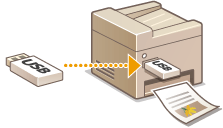
Available File Formats
You can print the following types of image files.
JPEG (DCF/Exif 2.21 or earlier/JFIF)
TIFF (JPEG/MH/MR/MMR compression)
|
NOTE
|
|
Maximum printable data size per file*1 is 50 MB*2.
*1 For multi-page TIFF files, maximum data size is per page.
*2 Maximum data size is 20 MB for the MF8580Cdw / MF8550Cdn / MF8540Cdn when Secure Print is enabled.
Note that even some files smaller than the size described above may not be printed correctly.
|
Available USB Memory Devices
You can use USB memory devices with the following format styles.
FAT16 (memory capacity: up to 2 GB)
FAT32 (memory capacity: up to 32 GB)
|
IMPORTANT
|
|
Do not use non-standard USB memory devices. You may not be able to print the images properly in some USB memory devices.
Do not connect anything other than a USB memory device. USB memory devices cannot be connected via a USB hub or an extension cable.
Do not use USB memory devices with special functions such as built-in security functions.
|
|
NOTE
|
|
The USB memory port of the machine supports USB 2.0.
If a folder in a USB memory device has many files, scanning image files to print will take more time. Use your computer to delete unnecessary files on your USB memory device or move them to a different folder.
|
1
Connect a USB memory device to the USB memory port.

IMPORTANT:
Do not remove the USB memory device or shock or shake the device or the machine when data is being read or written. Also, do not turn OFF the machine while the processing is in progress.
2
Press  (USB PRINT).
(USB PRINT).
 (USB PRINT).
(USB PRINT).3
Use  /
/ to select <Select File and Print>, and press
to select <Select File and Print>, and press  .
.
 /
/ to select <Select File and Print>, and press
to select <Select File and Print>, and press  .
.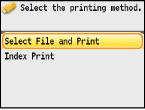
NOTE:
Index Print
Index Print
You can print thumbnails of the image files (JPEG only) stored in a USB memory device. To print the images in thumbnails, select <Index Print> on the screen, and proceed to the next step.
4
Select the file to print, and press  .
.
 .
.You can select multiple files.

To clear a selection, select the file you have selected (marked as  ), and press
), and press  .
.
 ), and press
), and press  .
.To display the contents of a folder, select a folder, and press  or
or  . To return to the folder in the upper level, press
. To return to the folder in the upper level, press  (Back) or
(Back) or  .
.
 or
or  . To return to the folder in the upper level, press
. To return to the folder in the upper level, press  (Back) or
(Back) or  .
.NOTE:
Folders and files lower than the third directory are not displayed.
When you move to another folder, the previous file selections will be cleared.
 To select all files
To select all files
|
1
|
Press <All Items>.
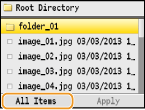 |
|
2
|
Select <Select All>, and press
 . .All the displayed files are selected.
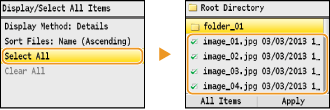 To clear all selections, select <Clear All>, and press
 . . |
 To display previews
To display previews
You can change the display method from <Details> (for file names and modification dates) to <Images> (for previews). By previewing images, you can check the file content before you select a file to print.
NOTE:
You can specify either <Details> or <Images> as the default display method. Default Display Settings
You can specify either <Details> or <Images> as the default display method. Default Display Settings
|
1
|
Press <All Items>.
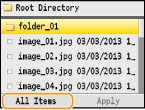 |
||||
|
2
|
Select <Display Method>, and press
 . .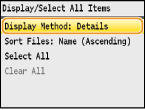 |
||||
|
3
|
Select the display method, and press
 . .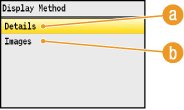  <Details> <Details>
 <Images> <Images>
|
 To change the file sort order
To change the file sort order
You can change the sort order of the files in a USB memory device.
NOTE:
You can specify a sort setting such as <Name (Ascending)> or <Date/Time (Ascending)> as the default setting for the file sort order. File Sort Default Settings
You can specify a sort setting such as <Name (Ascending)> or <Date/Time (Ascending)> as the default setting for the file sort order. File Sort Default Settings
|
1
|
Press <All Items>.
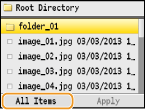 |
|
2
|
Select <Sort Files>, and press
 . .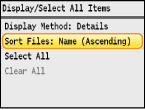 |
|
3
|
Select the criteria for file sorting, and press
 . .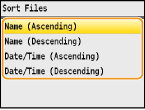 |
|
NOTE:
When you select <Date/Time (Ascending)> or <Date/Time (Descending)>, files are sorted based on the modification dates and time of the files.
|
5
Press <Apply>.
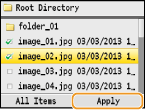
6
Specify the print settings as necessary.
Use  /
/ to select the settings, press
to select the settings, press  and specify each setting.
and specify each setting.
 /
/ to select the settings, press
to select the settings, press  and specify each setting.
and specify each setting.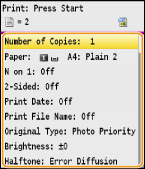
<Number of Copies>
Specify the number of copies from 1 to 99. Use  /
/ or the numeric keys to enter a quantity, and press <Apply>.
or the numeric keys to enter a quantity, and press <Apply>.
 /
/ or the numeric keys to enter a quantity, and press <Apply>.
or the numeric keys to enter a quantity, and press <Apply>.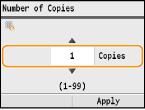
<Paper>
Select the paper to print on. Use  /
/ to select the paper, and press
to select the paper, and press  .
.
 /
/ to select the paper, and press
to select the paper, and press  .
.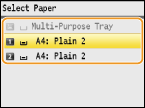
<N on 1>
You can print two or four images onto a single sheet. Use  /
/ to select <2 on 1> or <4 on 1>, and press
to select <2 on 1> or <4 on 1>, and press  .
.
 /
/ to select <2 on 1> or <4 on 1>, and press
to select <2 on 1> or <4 on 1>, and press  .
.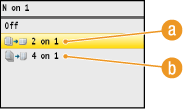
 <2 on 1>
<2 on 1>
Prints two images onto a single sheet.
 <4 on 1>
<4 on 1>
Prints four images onto a single sheet.
NOTE:
<N on 1> is not available for printing TIFF files.
<N on 1> is not available for printing TIFF files.
<2-Sided> (MF8580Cdw / MF8550Cdn / MF8540Cdn Only)
You can make 2-sided printouts. Use  /
/ to select the binding position, and press
to select the binding position, and press  .
.
 /
/ to select the binding position, and press
to select the binding position, and press  .
.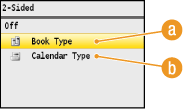
 <Book Type>
<Book Type>
Prints images in such a way that the printed pages are opened horizontally when bound.

 <Calendar Type>
<Calendar Type>
Prints images in such a way that the printed pages are opened vertically when bound.

NOTE:
<2-Sided> may not be available with some sizes or types of paper. Paper
<Print Date>
You can print the modification date of the file below each image. Use  /
/ to select <On>, and press
to select <On>, and press  .
.
 /
/ to select <On>, and press
to select <On>, and press  .
.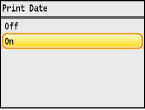
NOTE:
Although <Print Date> is not available for Index Print, the modification date of the file is automatically printed below each image.
Although <Print Date> is not available for Index Print, the modification date of the file is automatically printed below each image.
<Print File Name>
You can print the file name below each image. Use  /
/ to select <On>, and press
to select <On>, and press  .
.
 /
/ to select <On>, and press
to select <On>, and press  .
.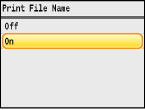
NOTE:
Although <Print File Name> is not available for Index Print, the file name is automatically printed below each image.
Although <Print File Name> is not available for Index Print, the file name is automatically printed below each image.
<Original Type>
You can select the type of original depending on the image to print. Use  /
/ to select <Photo Priority> or <Text Priority>, and press
to select <Photo Priority> or <Text Priority>, and press  .
.
 /
/ to select <Photo Priority> or <Text Priority>, and press
to select <Photo Priority> or <Text Priority>, and press  .
.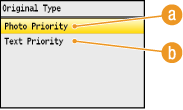
 <Photo Priority>
<Photo Priority>
Gives priority to printing photo images smoothly.
 <Text Priority>
<Text Priority>
Gives priority to printing text clearly.
<Brightness>
You can adjust the brightness of printouts. Use  /
/ to adjust the brightness, and press <Apply>.
to adjust the brightness, and press <Apply>.
 /
/ to adjust the brightness, and press <Apply>.
to adjust the brightness, and press <Apply>.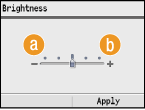
 <–>
<–>
Prints images darker.
 <+>
<+>
Prints images brighter.
NOTE:
You can adjust the brightness of TIFF files only when they are JPEG-compressed.
You can adjust the brightness of TIFF files only when they are JPEG-compressed.
<Halftones>
You can select the printing method to reproduce halftones (the intermediate range between the lighter and darker areas of an image) for optimal image quality. Use  /
/ to select <Gradation> or <Error Diffusion>, and press
to select <Gradation> or <Error Diffusion>, and press  .
.
 /
/ to select <Gradation> or <Error Diffusion>, and press
to select <Gradation> or <Error Diffusion>, and press  .
.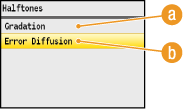
 <Gradation>
<Gradation>
Prints images with fine gradation, such as digital camera images, with a smooth finish.
 <Error Diffusion>
<Error Diffusion>
Prints images with small text or fine lines with a clear finish.
7
Press  .
.
 .
.Printing starts.
If you want to cancel printing, press <Cancel>  <Yes>
<Yes> 
 .
.
 <Yes>
<Yes> 
 .
.8
Disconnect the USB memory device from the USB memory port.
|
1
|
Press
 . . |
|
2
|
Press
 (Status Monitor). (Status Monitor). |
|
3
|
Use
 / / to select <Device Status>, and press to select <Device Status>, and press  . . |
|
4
|
Select <Remove Memory Media>, and press
 . .Wait until the message <The memory media can be safely removed.> is displayed.
|
|
5
|
Disconnect the USB memory device.
|
|
TIPS
|
|
If you always want to print with the same settings: Changing Default USB Print Settings
|
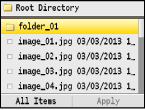
 to display a larger preview. Press
to display a larger preview. Press 